Master's Thesis: E-Commerce Adoption in Malaysian Small Hotels
VerifiedAdded on 2021/05/13
|59
|18176
|73
Project
AI Summary
This research proposal, prepared for a Master of Commerce by Thesis, investigates the determinants of e-commerce adoption among small-and-medium-sized hotels in Malaysia. The study aims to evaluate the current level of e-commerce adoption, identify influencing factors (including website evaluation and social media), explore components of successful adoption, and develop a comprehensive e-commerce adoption framework. The research methodology includes website evaluation analysis and a multiple case study involving interviews, observations, and document analysis across six Malaysian hotels. The proposal highlights the significance of the study in filling knowledge gaps, especially considering the growing importance of e-commerce in the tourism industry and the need for small-and-medium-sized hotels to compete effectively. The research will contribute to the strategic planning of the Malaysian hotel industry, harnessing the potential of e-commerce for both public and private sectors, while also considering ethical issues and expected outcomes.
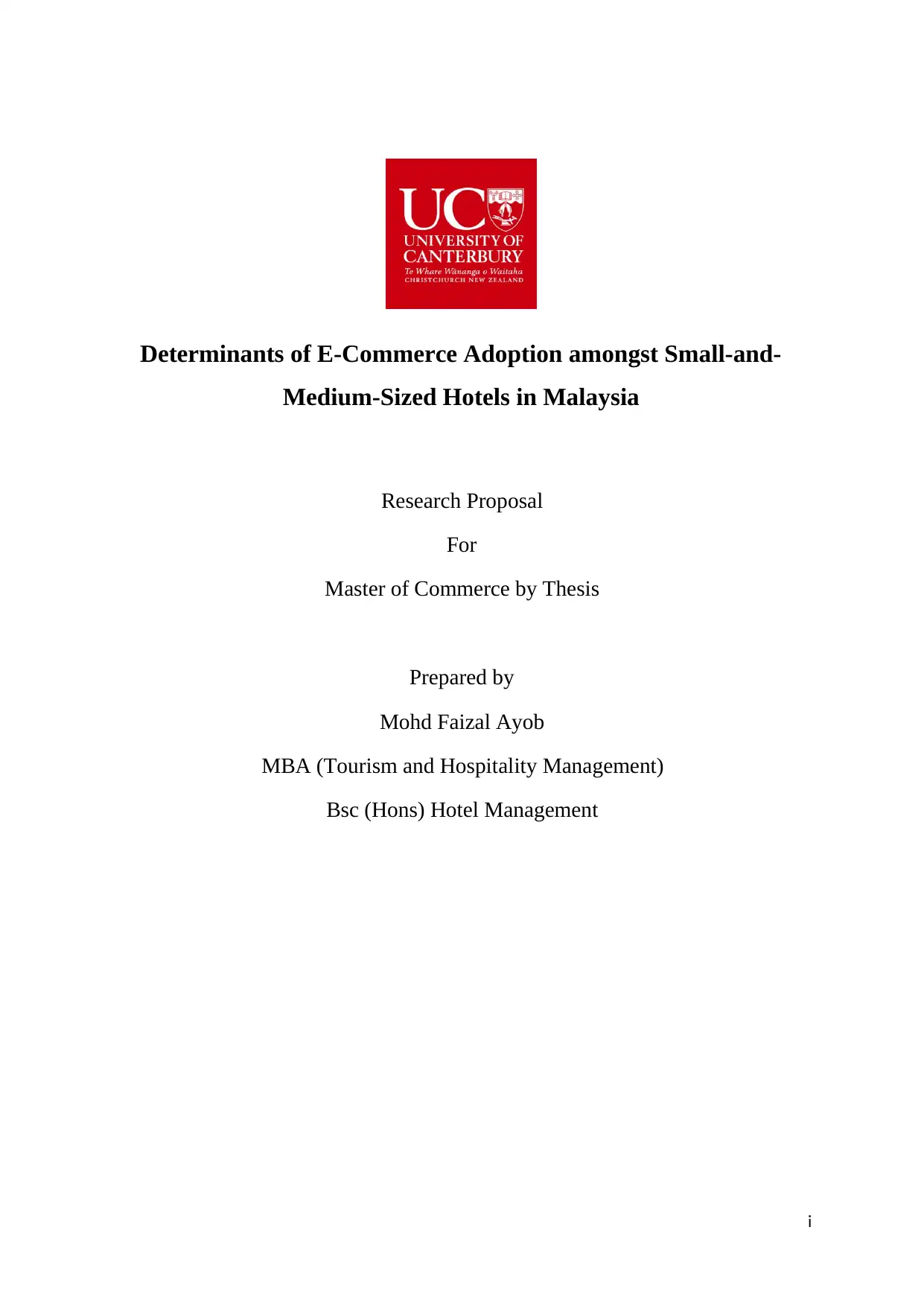
i
Determinants of E-Commerce Adoption amongst Small-and-
Medium-Sized Hotels in Malaysia
Research Proposal
For
Master of Commerce by Thesis
Prepared by
Mohd Faizal Ayob
MBA (Tourism and Hospitality Management)
Bsc (Hons) Hotel Management
Determinants of E-Commerce Adoption amongst Small-and-
Medium-Sized Hotels in Malaysia
Research Proposal
For
Master of Commerce by Thesis
Prepared by
Mohd Faizal Ayob
MBA (Tourism and Hospitality Management)
Bsc (Hons) Hotel Management
Paraphrase This Document
Need a fresh take? Get an instant paraphrase of this document with our AI Paraphraser
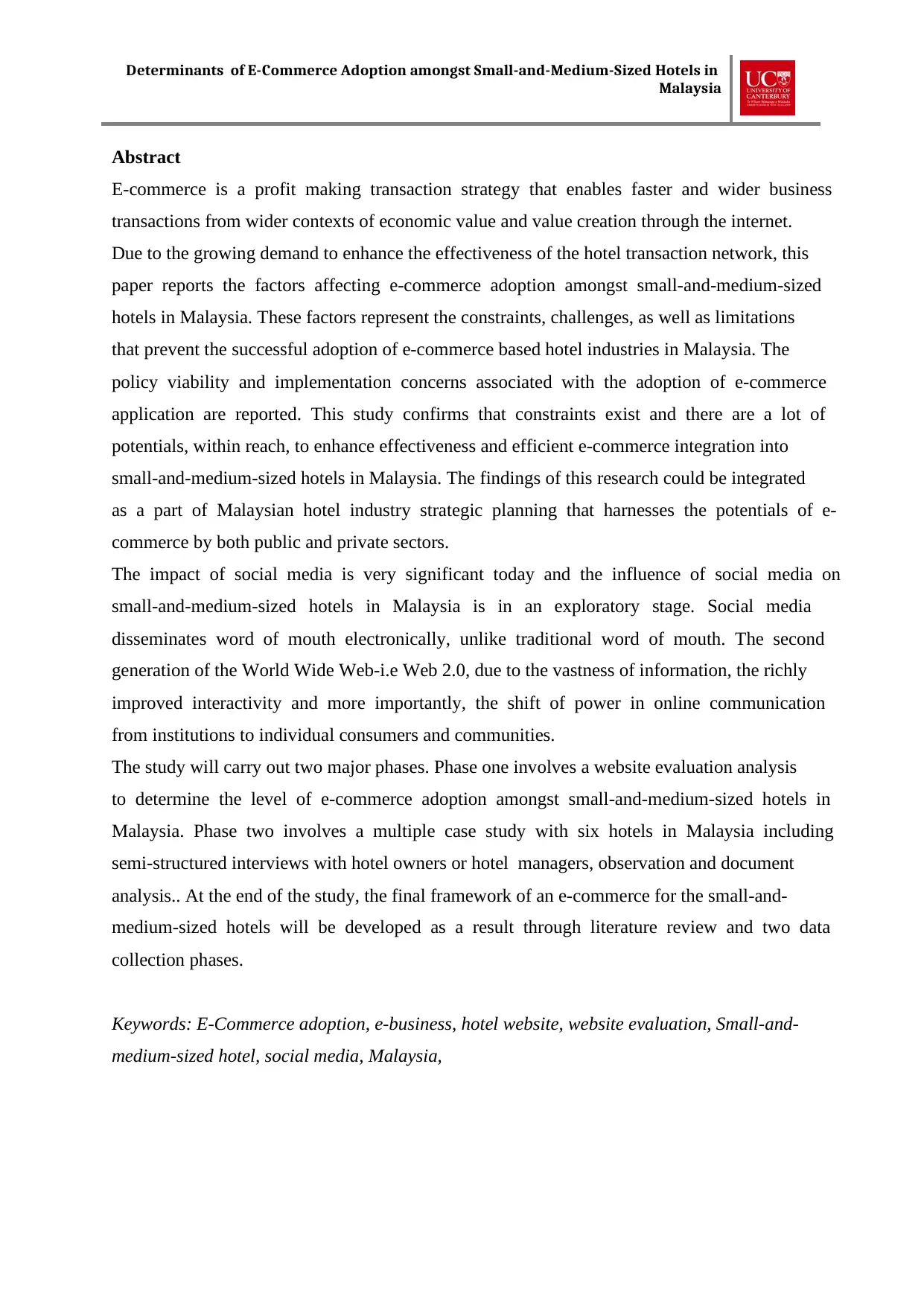
Determinants of E-Commerce Adoption amongst Small-and-Medium-Sized Hotels in
Malaysia
Abstract
E-commerce is a profit making transaction strategy that enables faster and wider business
transactions from wider contexts of economic value and value creation through the internet.
Due to the growing demand to enhance the effectiveness of the hotel transaction network, this
paper reports the factors affecting e-commerce adoption amongst small-and-medium-sized
hotels in Malaysia. These factors represent the constraints, challenges, as well as limitations
that prevent the successful adoption of e-commerce based hotel industries in Malaysia. The
policy viability and implementation concerns associated with the adoption of e-commerce
application are reported. This study confirms that constraints exist and there are a lot of
potentials, within reach, to enhance effectiveness and efficient e-commerce integration into
small-and-medium-sized hotels in Malaysia. The findings of this research could be integrated
as a part of Malaysian hotel industry strategic planning that harnesses the potentials of e-
commerce by both public and private sectors.
The impact of social media is very significant today and the influence of social media on
small-and-medium-sized hotels in Malaysia is in an exploratory stage. Social media
disseminates word of mouth electronically, unlike traditional word of mouth. The second
generation of the World Wide Web-i.e Web 2.0, due to the vastness of information, the richly
improved interactivity and more importantly, the shift of power in online communication
from institutions to individual consumers and communities.
The study will carry out two major phases. Phase one involves a website evaluation analysis
to determine the level of e-commerce adoption amongst small-and-medium-sized hotels in
Malaysia. Phase two involves a multiple case study with six hotels in Malaysia including
semi-structured interviews with hotel owners or hotel managers, observation and document
analysis.. At the end of the study, the final framework of an e-commerce for the small-and-
medium-sized hotels will be developed as a result through literature review and two data
collection phases.
Keywords: E-Commerce adoption, e-business, hotel website, website evaluation, Small-and-
medium-sized hotel, social media, Malaysia,
Malaysia
Abstract
E-commerce is a profit making transaction strategy that enables faster and wider business
transactions from wider contexts of economic value and value creation through the internet.
Due to the growing demand to enhance the effectiveness of the hotel transaction network, this
paper reports the factors affecting e-commerce adoption amongst small-and-medium-sized
hotels in Malaysia. These factors represent the constraints, challenges, as well as limitations
that prevent the successful adoption of e-commerce based hotel industries in Malaysia. The
policy viability and implementation concerns associated with the adoption of e-commerce
application are reported. This study confirms that constraints exist and there are a lot of
potentials, within reach, to enhance effectiveness and efficient e-commerce integration into
small-and-medium-sized hotels in Malaysia. The findings of this research could be integrated
as a part of Malaysian hotel industry strategic planning that harnesses the potentials of e-
commerce by both public and private sectors.
The impact of social media is very significant today and the influence of social media on
small-and-medium-sized hotels in Malaysia is in an exploratory stage. Social media
disseminates word of mouth electronically, unlike traditional word of mouth. The second
generation of the World Wide Web-i.e Web 2.0, due to the vastness of information, the richly
improved interactivity and more importantly, the shift of power in online communication
from institutions to individual consumers and communities.
The study will carry out two major phases. Phase one involves a website evaluation analysis
to determine the level of e-commerce adoption amongst small-and-medium-sized hotels in
Malaysia. Phase two involves a multiple case study with six hotels in Malaysia including
semi-structured interviews with hotel owners or hotel managers, observation and document
analysis.. At the end of the study, the final framework of an e-commerce for the small-and-
medium-sized hotels will be developed as a result through literature review and two data
collection phases.
Keywords: E-Commerce adoption, e-business, hotel website, website evaluation, Small-and-
medium-sized hotel, social media, Malaysia,
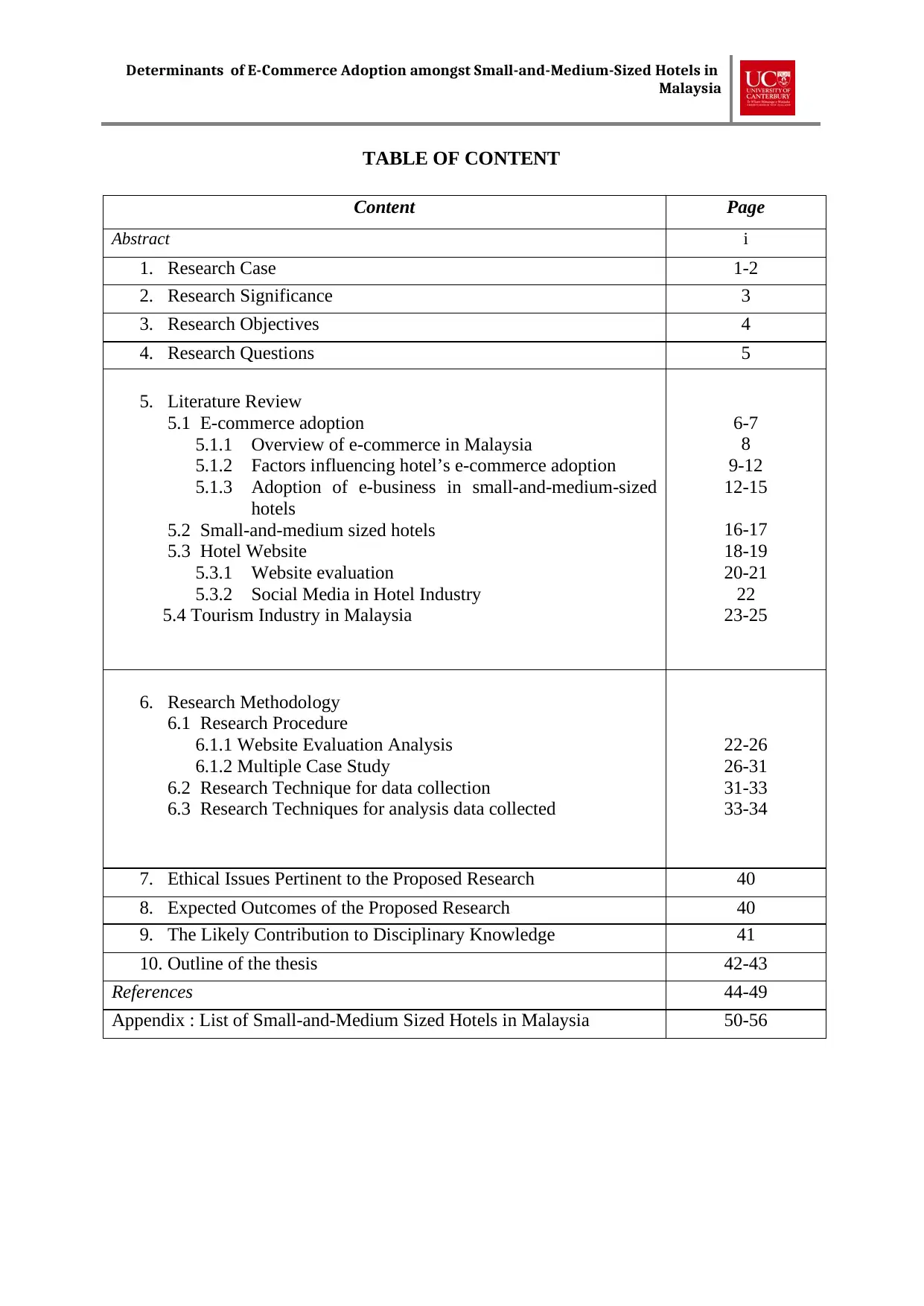
Determinants of E-Commerce Adoption amongst Small-and-Medium-Sized Hotels in
Malaysia
TABLE OF CONTENT
Content Page
Abstract i
1. Research Case 1-2
2. Research Significance 3
3. Research Objectives 4
4. Research Questions 5
5. Literature Review
5.1 E-commerce adoption
5.1.1 Overview of e-commerce in Malaysia
5.1.2 Factors influencing hotel’s e-commerce adoption
5.1.3 Adoption of e-business in small-and-medium-sized
hotels
5.2 Small-and-medium sized hotels
5.3 Hotel Website
5.3.1 Website evaluation
5.3.2 Social Media in Hotel Industry
5.4 Tourism Industry in Malaysia
6-7
8
9-12
12-15
16-17
18-19
20-21
22
23-25
6. Research Methodology
6.1 Research Procedure
6.1.1 Website Evaluation Analysis
6.1.2 Multiple Case Study
6.2 Research Technique for data collection
6.3 Research Techniques for analysis data collected
22-26
26-31
31-33
33-34
7. Ethical Issues Pertinent to the Proposed Research 40
8. Expected Outcomes of the Proposed Research 40
9. The Likely Contribution to Disciplinary Knowledge 41
10. Outline of the thesis 42-43
References 44-49
Appendix : List of Small-and-Medium Sized Hotels in Malaysia 50-56
Malaysia
TABLE OF CONTENT
Content Page
Abstract i
1. Research Case 1-2
2. Research Significance 3
3. Research Objectives 4
4. Research Questions 5
5. Literature Review
5.1 E-commerce adoption
5.1.1 Overview of e-commerce in Malaysia
5.1.2 Factors influencing hotel’s e-commerce adoption
5.1.3 Adoption of e-business in small-and-medium-sized
hotels
5.2 Small-and-medium sized hotels
5.3 Hotel Website
5.3.1 Website evaluation
5.3.2 Social Media in Hotel Industry
5.4 Tourism Industry in Malaysia
6-7
8
9-12
12-15
16-17
18-19
20-21
22
23-25
6. Research Methodology
6.1 Research Procedure
6.1.1 Website Evaluation Analysis
6.1.2 Multiple Case Study
6.2 Research Technique for data collection
6.3 Research Techniques for analysis data collected
22-26
26-31
31-33
33-34
7. Ethical Issues Pertinent to the Proposed Research 40
8. Expected Outcomes of the Proposed Research 40
9. The Likely Contribution to Disciplinary Knowledge 41
10. Outline of the thesis 42-43
References 44-49
Appendix : List of Small-and-Medium Sized Hotels in Malaysia 50-56
⊘ This is a preview!⊘
Do you want full access?
Subscribe today to unlock all pages.

Trusted by 1+ million students worldwide
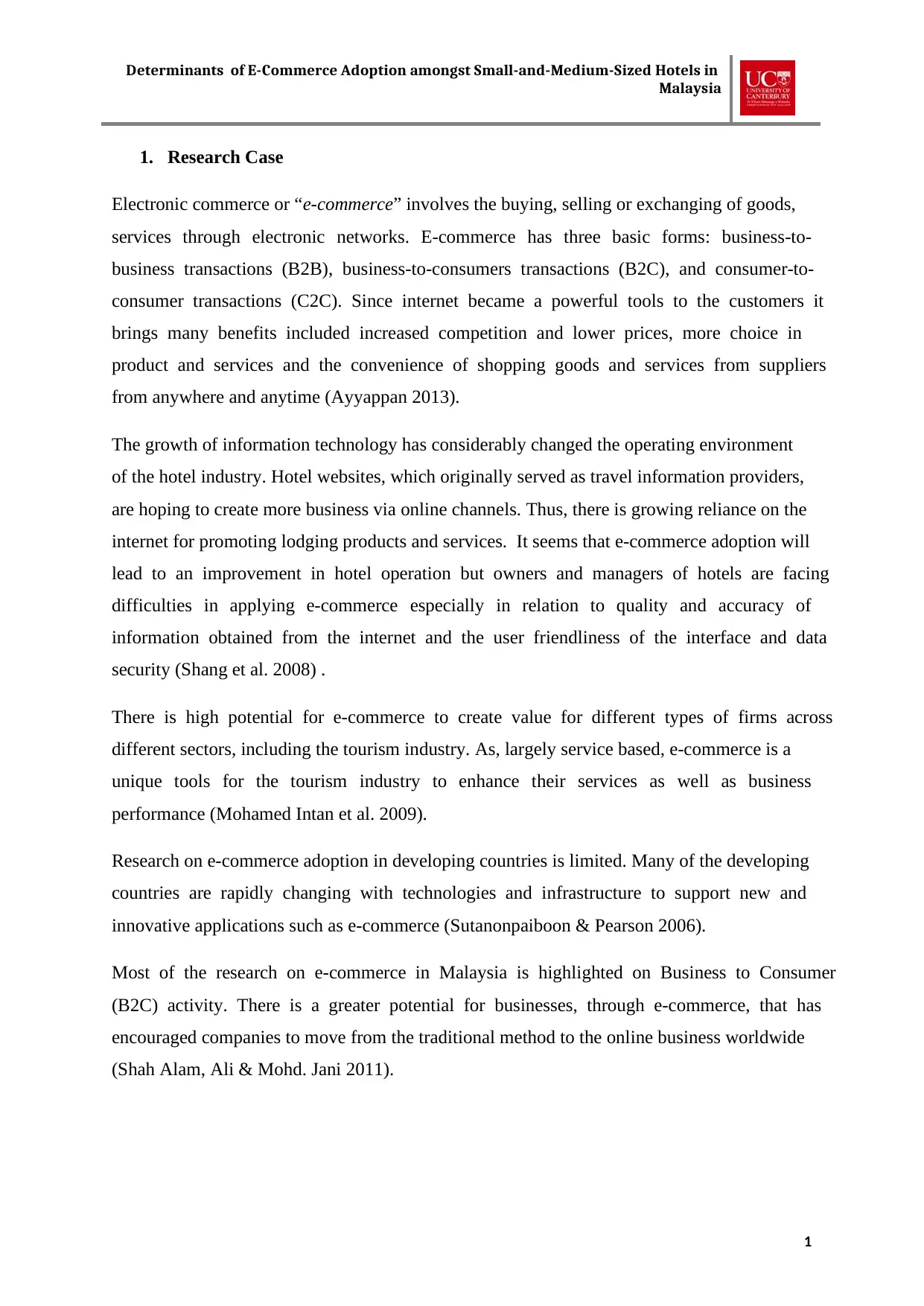
Determinants of E-Commerce Adoption amongst Small-and-Medium-Sized Hotels in
Malaysia
1
1. Research Case
Electronic commerce or “e-commerce” involves the buying, selling or exchanging of goods,
services through electronic networks. E-commerce has three basic forms: business-to-
business transactions (B2B), business-to-consumers transactions (B2C), and consumer-to-
consumer transactions (C2C). Since internet became a powerful tools to the customers it
brings many benefits included increased competition and lower prices, more choice in
product and services and the convenience of shopping goods and services from suppliers
from anywhere and anytime (Ayyappan 2013).
The growth of information technology has considerably changed the operating environment
of the hotel industry. Hotel websites, which originally served as travel information providers,
are hoping to create more business via online channels. Thus, there is growing reliance on the
internet for promoting lodging products and services. It seems that e-commerce adoption will
lead to an improvement in hotel operation but owners and managers of hotels are facing
difficulties in applying e-commerce especially in relation to quality and accuracy of
information obtained from the internet and the user friendliness of the interface and data
security (Shang et al. 2008) .
There is high potential for e-commerce to create value for different types of firms across
different sectors, including the tourism industry. As, largely service based, e-commerce is a
unique tools for the tourism industry to enhance their services as well as business
performance (Mohamed Intan et al. 2009).
Research on e-commerce adoption in developing countries is limited. Many of the developing
countries are rapidly changing with technologies and infrastructure to support new and
innovative applications such as e-commerce (Sutanonpaiboon & Pearson 2006).
Most of the research on e-commerce in Malaysia is highlighted on Business to Consumer
(B2C) activity. There is a greater potential for businesses, through e-commerce, that has
encouraged companies to move from the traditional method to the online business worldwide
(Shah Alam, Ali & Mohd. Jani 2011).
Malaysia
1
1. Research Case
Electronic commerce or “e-commerce” involves the buying, selling or exchanging of goods,
services through electronic networks. E-commerce has three basic forms: business-to-
business transactions (B2B), business-to-consumers transactions (B2C), and consumer-to-
consumer transactions (C2C). Since internet became a powerful tools to the customers it
brings many benefits included increased competition and lower prices, more choice in
product and services and the convenience of shopping goods and services from suppliers
from anywhere and anytime (Ayyappan 2013).
The growth of information technology has considerably changed the operating environment
of the hotel industry. Hotel websites, which originally served as travel information providers,
are hoping to create more business via online channels. Thus, there is growing reliance on the
internet for promoting lodging products and services. It seems that e-commerce adoption will
lead to an improvement in hotel operation but owners and managers of hotels are facing
difficulties in applying e-commerce especially in relation to quality and accuracy of
information obtained from the internet and the user friendliness of the interface and data
security (Shang et al. 2008) .
There is high potential for e-commerce to create value for different types of firms across
different sectors, including the tourism industry. As, largely service based, e-commerce is a
unique tools for the tourism industry to enhance their services as well as business
performance (Mohamed Intan et al. 2009).
Research on e-commerce adoption in developing countries is limited. Many of the developing
countries are rapidly changing with technologies and infrastructure to support new and
innovative applications such as e-commerce (Sutanonpaiboon & Pearson 2006).
Most of the research on e-commerce in Malaysia is highlighted on Business to Consumer
(B2C) activity. There is a greater potential for businesses, through e-commerce, that has
encouraged companies to move from the traditional method to the online business worldwide
(Shah Alam, Ali & Mohd. Jani 2011).
Paraphrase This Document
Need a fresh take? Get an instant paraphrase of this document with our AI Paraphraser
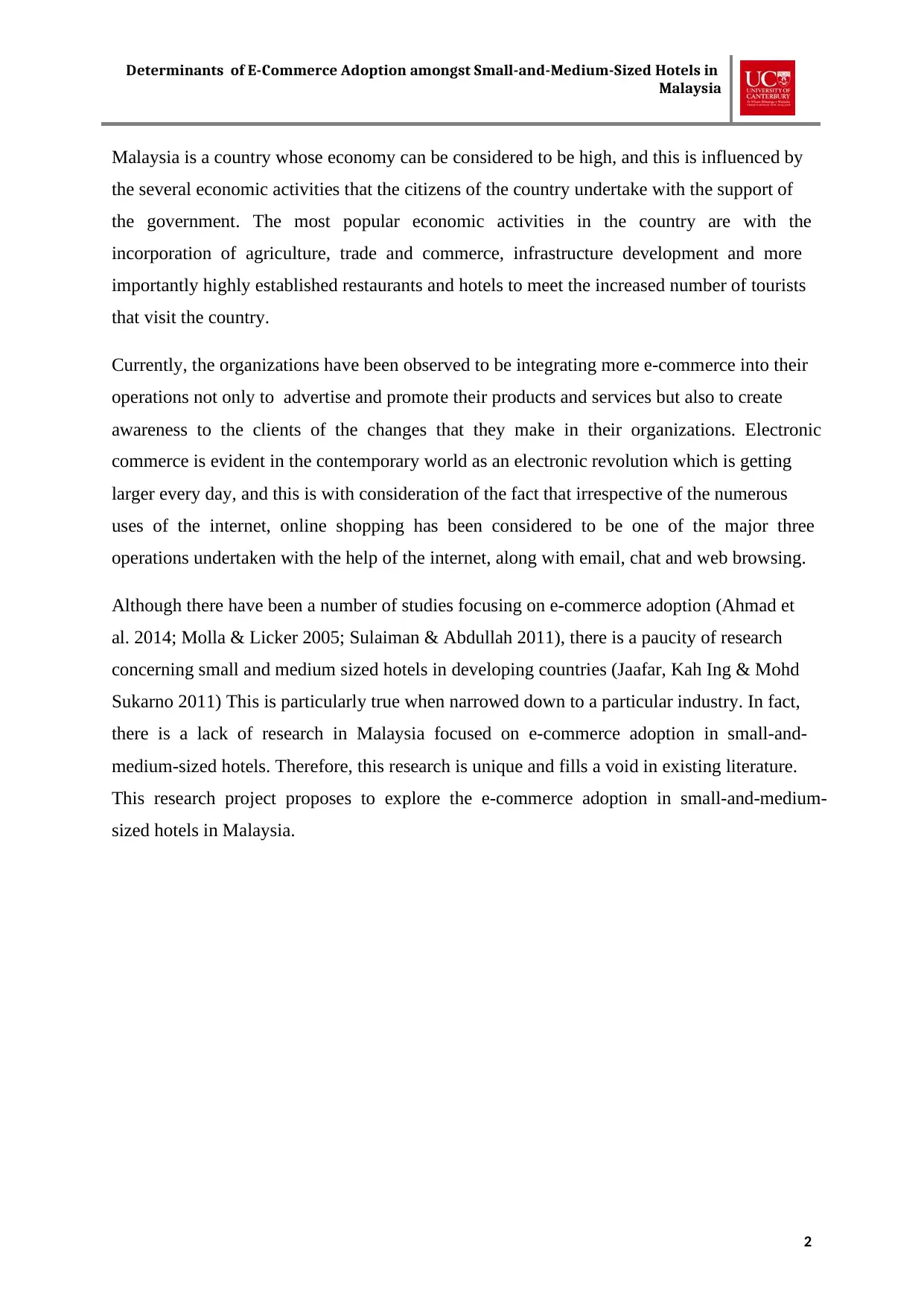
Determinants of E-Commerce Adoption amongst Small-and-Medium-Sized Hotels in
Malaysia
2
Malaysia is a country whose economy can be considered to be high, and this is influenced by
the several economic activities that the citizens of the country undertake with the support of
the government. The most popular economic activities in the country are with the
incorporation of agriculture, trade and commerce, infrastructure development and more
importantly highly established restaurants and hotels to meet the increased number of tourists
that visit the country.
Currently, the organizations have been observed to be integrating more e-commerce into their
operations not only to advertise and promote their products and services but also to create
awareness to the clients of the changes that they make in their organizations. Electronic
commerce is evident in the contemporary world as an electronic revolution which is getting
larger every day, and this is with consideration of the fact that irrespective of the numerous
uses of the internet, online shopping has been considered to be one of the major three
operations undertaken with the help of the internet, along with email, chat and web browsing.
Although there have been a number of studies focusing on e-commerce adoption (Ahmad et
al. 2014; Molla & Licker 2005; Sulaiman & Abdullah 2011), there is a paucity of research
concerning small and medium sized hotels in developing countries (Jaafar, Kah Ing & Mohd
Sukarno 2011) This is particularly true when narrowed down to a particular industry. In fact,
there is a lack of research in Malaysia focused on e-commerce adoption in small-and-
medium-sized hotels. Therefore, this research is unique and fills a void in existing literature.
This research project proposes to explore the e-commerce adoption in small-and-medium-
sized hotels in Malaysia.
Malaysia
2
Malaysia is a country whose economy can be considered to be high, and this is influenced by
the several economic activities that the citizens of the country undertake with the support of
the government. The most popular economic activities in the country are with the
incorporation of agriculture, trade and commerce, infrastructure development and more
importantly highly established restaurants and hotels to meet the increased number of tourists
that visit the country.
Currently, the organizations have been observed to be integrating more e-commerce into their
operations not only to advertise and promote their products and services but also to create
awareness to the clients of the changes that they make in their organizations. Electronic
commerce is evident in the contemporary world as an electronic revolution which is getting
larger every day, and this is with consideration of the fact that irrespective of the numerous
uses of the internet, online shopping has been considered to be one of the major three
operations undertaken with the help of the internet, along with email, chat and web browsing.
Although there have been a number of studies focusing on e-commerce adoption (Ahmad et
al. 2014; Molla & Licker 2005; Sulaiman & Abdullah 2011), there is a paucity of research
concerning small and medium sized hotels in developing countries (Jaafar, Kah Ing & Mohd
Sukarno 2011) This is particularly true when narrowed down to a particular industry. In fact,
there is a lack of research in Malaysia focused on e-commerce adoption in small-and-
medium-sized hotels. Therefore, this research is unique and fills a void in existing literature.
This research project proposes to explore the e-commerce adoption in small-and-medium-
sized hotels in Malaysia.
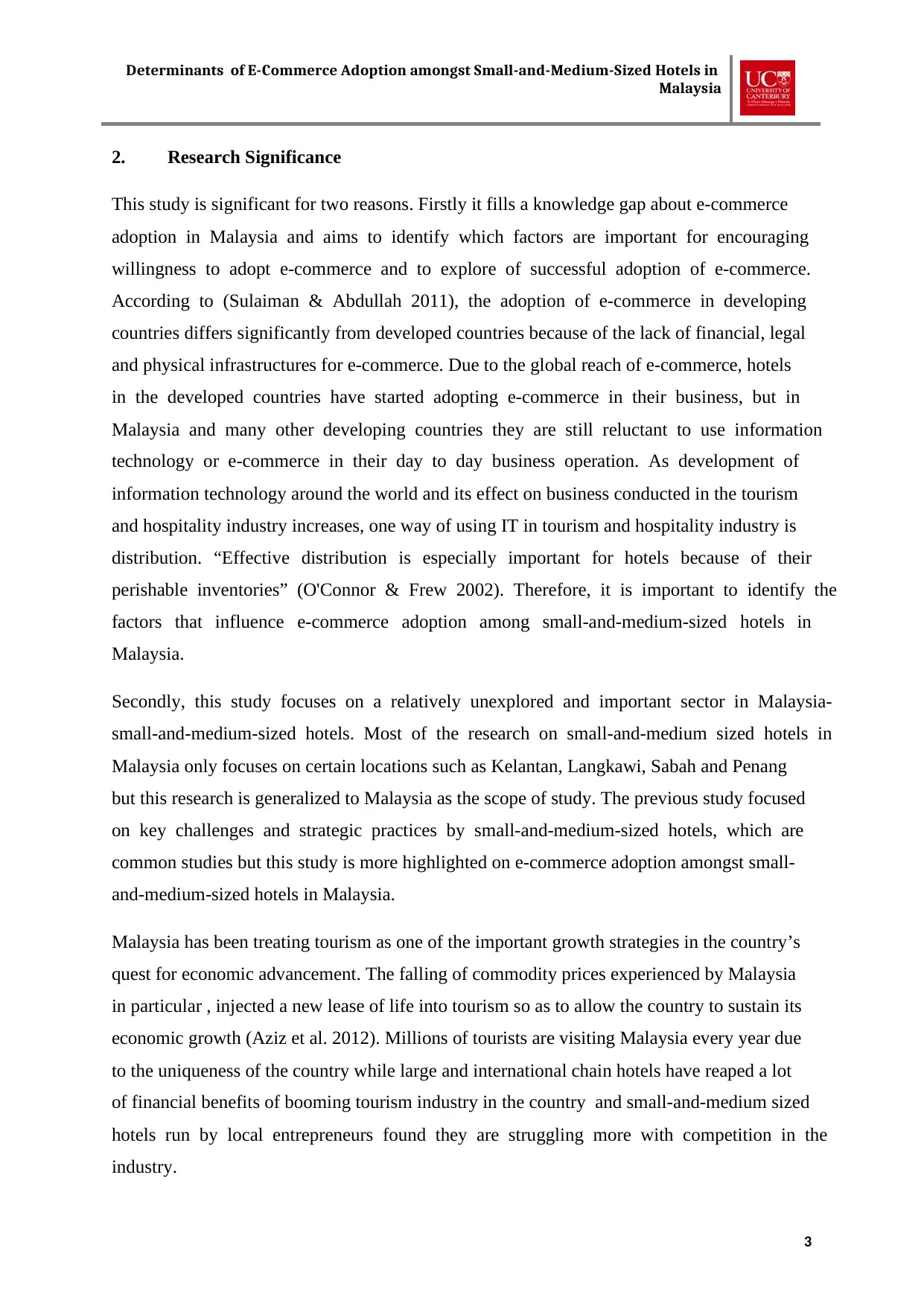
Determinants of E-Commerce Adoption amongst Small-and-Medium-Sized Hotels in
Malaysia
3
2. Research Significance
This study is significant for two reasons. Firstly it fills a knowledge gap about e-commerce
adoption in Malaysia and aims to identify which factors are important for encouraging
willingness to adopt e-commerce and to explore of successful adoption of e-commerce.
According to (Sulaiman & Abdullah 2011), the adoption of e-commerce in developing
countries differs significantly from developed countries because of the lack of financial, legal
and physical infrastructures for e-commerce. Due to the global reach of e-commerce, hotels
in the developed countries have started adopting e-commerce in their business, but in
Malaysia and many other developing countries they are still reluctant to use information
technology or e-commerce in their day to day business operation. As development of
information technology around the world and its effect on business conducted in the tourism
and hospitality industry increases, one way of using IT in tourism and hospitality industry is
distribution. “Effective distribution is especially important for hotels because of their
perishable inventories” (O'Connor & Frew 2002). Therefore, it is important to identify the
factors that influence e-commerce adoption among small-and-medium-sized hotels in
Malaysia.
Secondly, this study focuses on a relatively unexplored and important sector in Malaysia-
small-and-medium-sized hotels. Most of the research on small-and-medium sized hotels in
Malaysia only focuses on certain locations such as Kelantan, Langkawi, Sabah and Penang
but this research is generalized to Malaysia as the scope of study. The previous study focused
on key challenges and strategic practices by small-and-medium-sized hotels, which are
common studies but this study is more highlighted on e-commerce adoption amongst small-
and-medium-sized hotels in Malaysia.
Malaysia has been treating tourism as one of the important growth strategies in the country’s
quest for economic advancement. The falling of commodity prices experienced by Malaysia
in particular , injected a new lease of life into tourism so as to allow the country to sustain its
economic growth (Aziz et al. 2012). Millions of tourists are visiting Malaysia every year due
to the uniqueness of the country while large and international chain hotels have reaped a lot
of financial benefits of booming tourism industry in the country and small-and-medium sized
hotels run by local entrepreneurs found they are struggling more with competition in the
industry.
Malaysia
3
2. Research Significance
This study is significant for two reasons. Firstly it fills a knowledge gap about e-commerce
adoption in Malaysia and aims to identify which factors are important for encouraging
willingness to adopt e-commerce and to explore of successful adoption of e-commerce.
According to (Sulaiman & Abdullah 2011), the adoption of e-commerce in developing
countries differs significantly from developed countries because of the lack of financial, legal
and physical infrastructures for e-commerce. Due to the global reach of e-commerce, hotels
in the developed countries have started adopting e-commerce in their business, but in
Malaysia and many other developing countries they are still reluctant to use information
technology or e-commerce in their day to day business operation. As development of
information technology around the world and its effect on business conducted in the tourism
and hospitality industry increases, one way of using IT in tourism and hospitality industry is
distribution. “Effective distribution is especially important for hotels because of their
perishable inventories” (O'Connor & Frew 2002). Therefore, it is important to identify the
factors that influence e-commerce adoption among small-and-medium-sized hotels in
Malaysia.
Secondly, this study focuses on a relatively unexplored and important sector in Malaysia-
small-and-medium-sized hotels. Most of the research on small-and-medium sized hotels in
Malaysia only focuses on certain locations such as Kelantan, Langkawi, Sabah and Penang
but this research is generalized to Malaysia as the scope of study. The previous study focused
on key challenges and strategic practices by small-and-medium-sized hotels, which are
common studies but this study is more highlighted on e-commerce adoption amongst small-
and-medium-sized hotels in Malaysia.
Malaysia has been treating tourism as one of the important growth strategies in the country’s
quest for economic advancement. The falling of commodity prices experienced by Malaysia
in particular , injected a new lease of life into tourism so as to allow the country to sustain its
economic growth (Aziz et al. 2012). Millions of tourists are visiting Malaysia every year due
to the uniqueness of the country while large and international chain hotels have reaped a lot
of financial benefits of booming tourism industry in the country and small-and-medium sized
hotels run by local entrepreneurs found they are struggling more with competition in the
industry.
⊘ This is a preview!⊘
Do you want full access?
Subscribe today to unlock all pages.

Trusted by 1+ million students worldwide
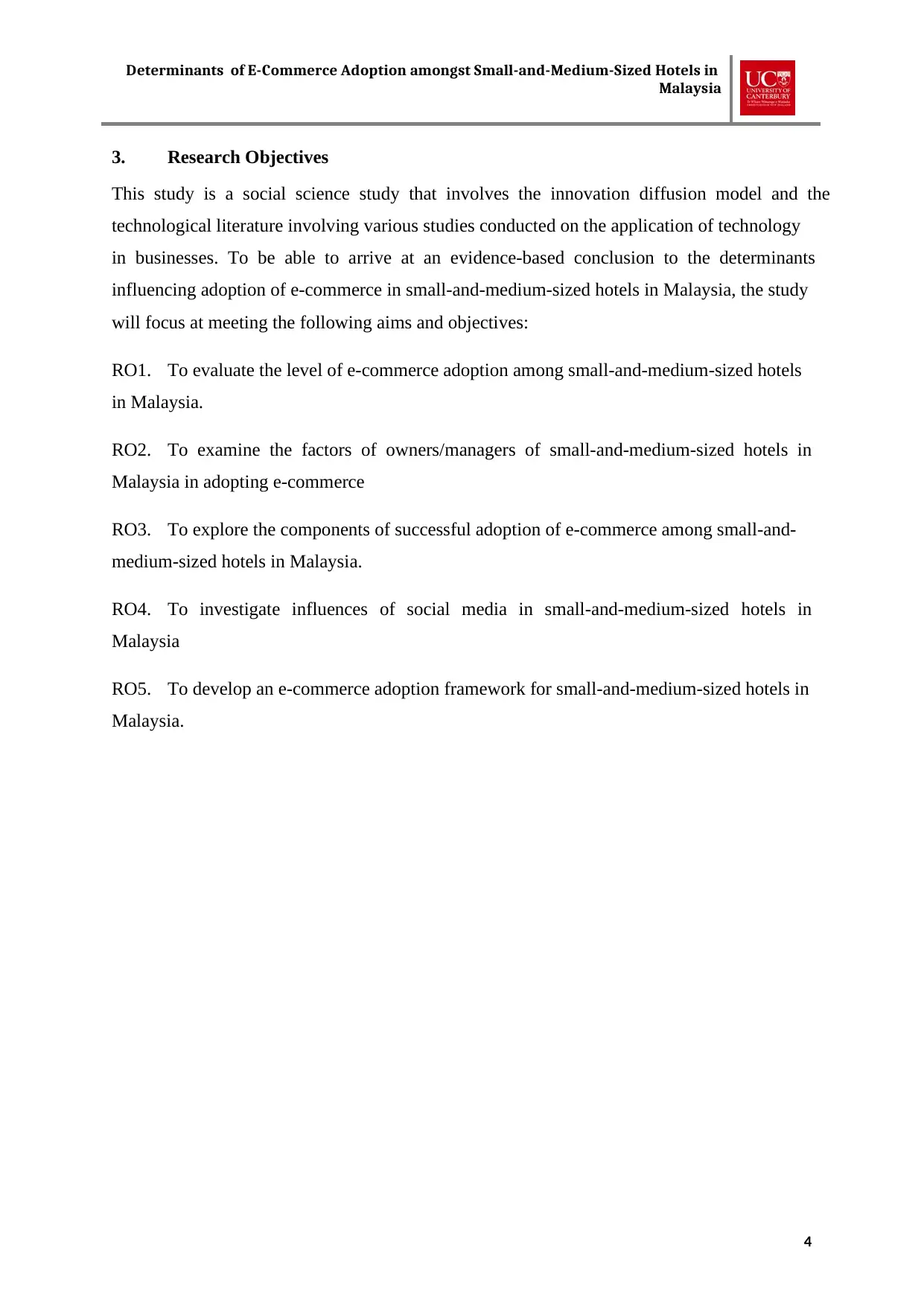
Determinants of E-Commerce Adoption amongst Small-and-Medium-Sized Hotels in
Malaysia
4
3. Research Objectives
This study is a social science study that involves the innovation diffusion model and the
technological literature involving various studies conducted on the application of technology
in businesses. To be able to arrive at an evidence-based conclusion to the determinants
influencing adoption of e-commerce in small-and-medium-sized hotels in Malaysia, the study
will focus at meeting the following aims and objectives:
RO1. To evaluate the level of e-commerce adoption among small-and-medium-sized hotels
in Malaysia.
RO2. To examine the factors of owners/managers of small-and-medium-sized hotels in
Malaysia in adopting e-commerce
RO3. To explore the components of successful adoption of e-commerce among small-and-
medium-sized hotels in Malaysia.
RO4. To investigate influences of social media in small-and-medium-sized hotels in
Malaysia
RO5. To develop an e-commerce adoption framework for small-and-medium-sized hotels in
Malaysia.
Malaysia
4
3. Research Objectives
This study is a social science study that involves the innovation diffusion model and the
technological literature involving various studies conducted on the application of technology
in businesses. To be able to arrive at an evidence-based conclusion to the determinants
influencing adoption of e-commerce in small-and-medium-sized hotels in Malaysia, the study
will focus at meeting the following aims and objectives:
RO1. To evaluate the level of e-commerce adoption among small-and-medium-sized hotels
in Malaysia.
RO2. To examine the factors of owners/managers of small-and-medium-sized hotels in
Malaysia in adopting e-commerce
RO3. To explore the components of successful adoption of e-commerce among small-and-
medium-sized hotels in Malaysia.
RO4. To investigate influences of social media in small-and-medium-sized hotels in
Malaysia
RO5. To develop an e-commerce adoption framework for small-and-medium-sized hotels in
Malaysia.
Paraphrase This Document
Need a fresh take? Get an instant paraphrase of this document with our AI Paraphraser
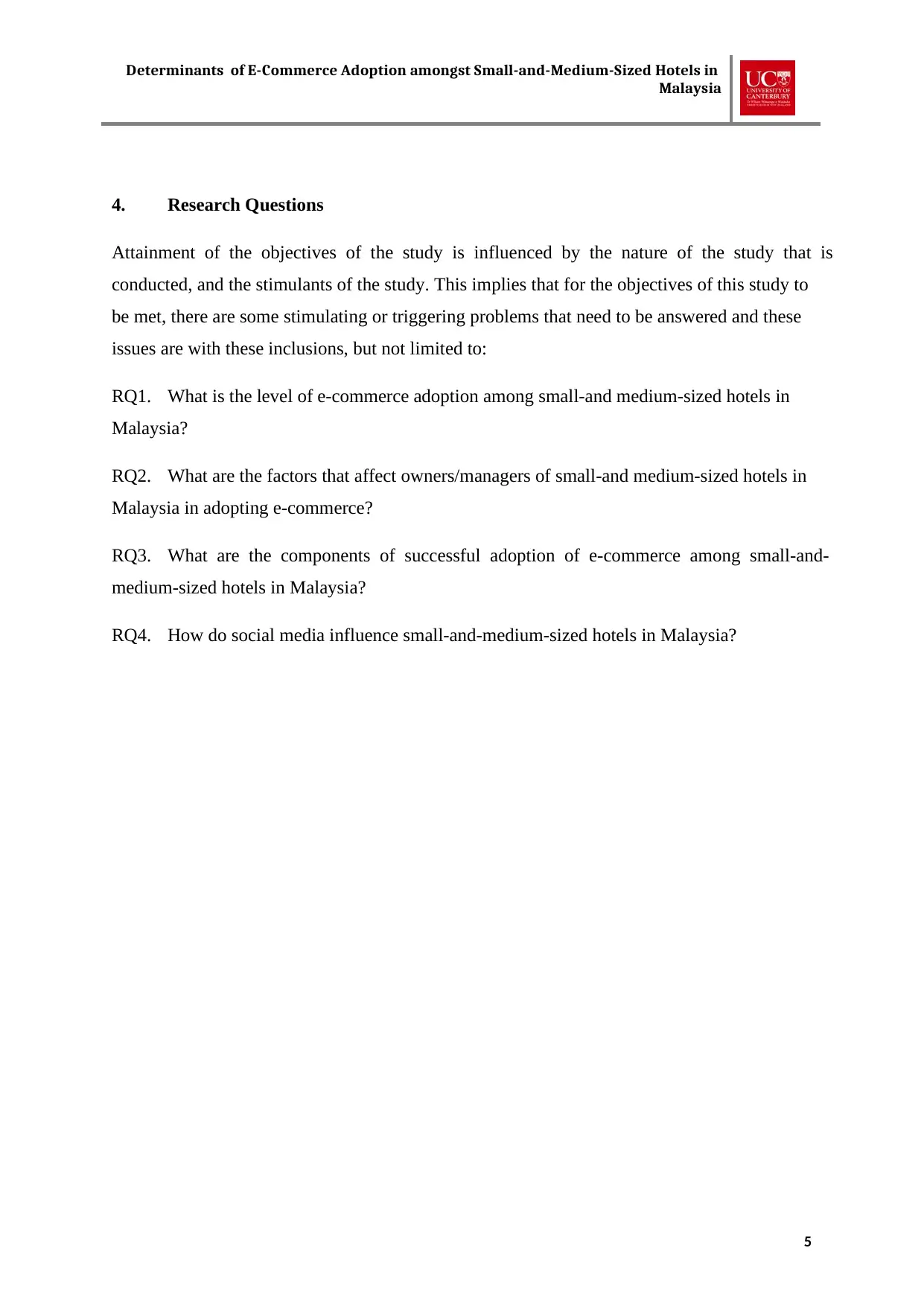
Determinants of E-Commerce Adoption amongst Small-and-Medium-Sized Hotels in
Malaysia
5
4. Research Questions
Attainment of the objectives of the study is influenced by the nature of the study that is
conducted, and the stimulants of the study. This implies that for the objectives of this study to
be met, there are some stimulating or triggering problems that need to be answered and these
issues are with these inclusions, but not limited to:
RQ1. What is the level of e-commerce adoption among small-and medium-sized hotels in
Malaysia?
RQ2. What are the factors that affect owners/managers of small-and medium-sized hotels in
Malaysia in adopting e-commerce?
RQ3. What are the components of successful adoption of e-commerce among small-and-
medium-sized hotels in Malaysia?
RQ4. How do social media influence small-and-medium-sized hotels in Malaysia?
Malaysia
5
4. Research Questions
Attainment of the objectives of the study is influenced by the nature of the study that is
conducted, and the stimulants of the study. This implies that for the objectives of this study to
be met, there are some stimulating or triggering problems that need to be answered and these
issues are with these inclusions, but not limited to:
RQ1. What is the level of e-commerce adoption among small-and medium-sized hotels in
Malaysia?
RQ2. What are the factors that affect owners/managers of small-and medium-sized hotels in
Malaysia in adopting e-commerce?
RQ3. What are the components of successful adoption of e-commerce among small-and-
medium-sized hotels in Malaysia?
RQ4. How do social media influence small-and-medium-sized hotels in Malaysia?
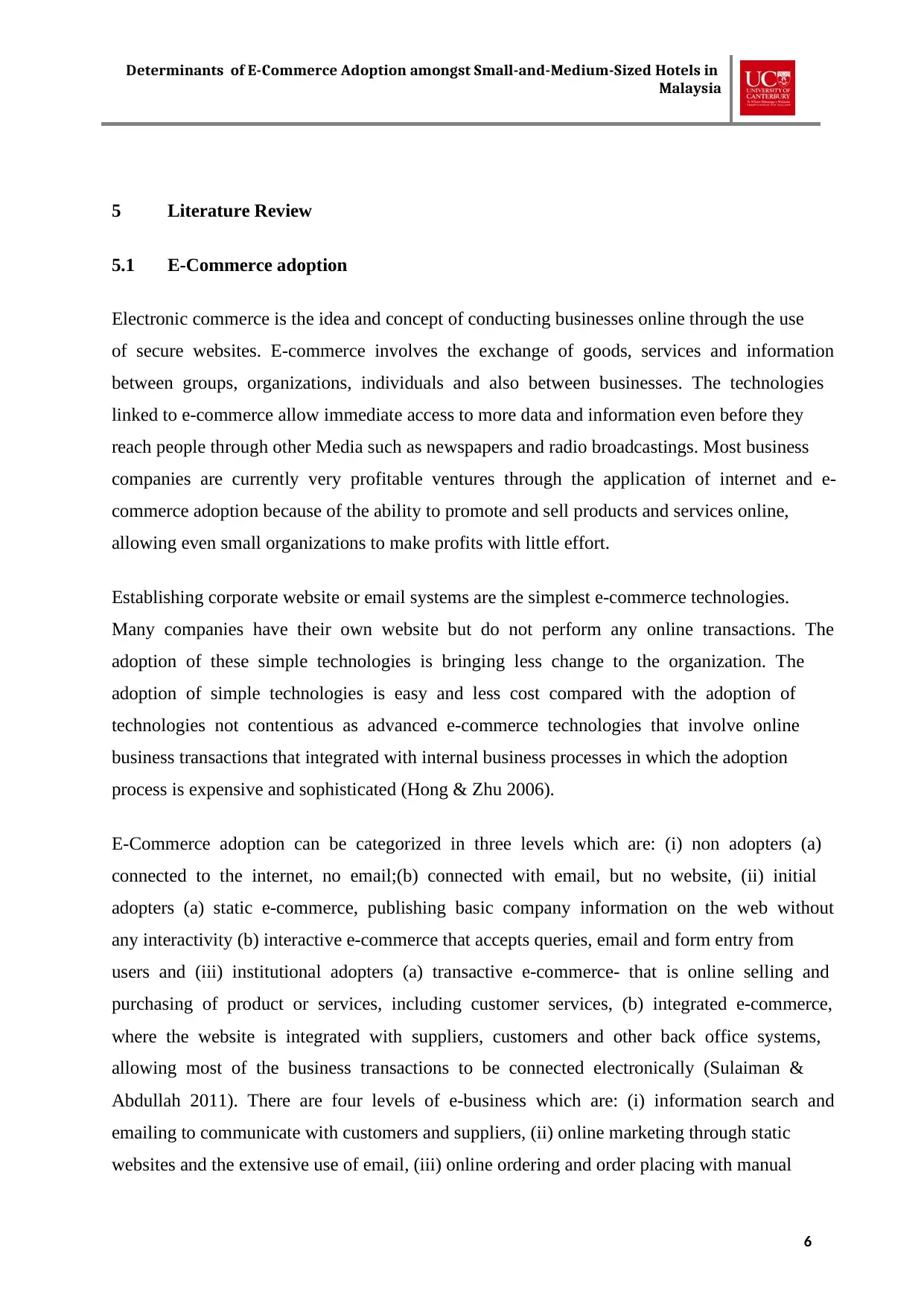
Determinants of E-Commerce Adoption amongst Small-and-Medium-Sized Hotels in
Malaysia
6
5 Literature Review
5.1 E-Commerce adoption
Electronic commerce is the idea and concept of conducting businesses online through the use
of secure websites. E-commerce involves the exchange of goods, services and information
between groups, organizations, individuals and also between businesses. The technologies
linked to e-commerce allow immediate access to more data and information even before they
reach people through other Media such as newspapers and radio broadcastings. Most business
companies are currently very profitable ventures through the application of internet and e-
commerce adoption because of the ability to promote and sell products and services online,
allowing even small organizations to make profits with little effort.
Establishing corporate website or email systems are the simplest e-commerce technologies.
Many companies have their own website but do not perform any online transactions. The
adoption of these simple technologies is bringing less change to the organization. The
adoption of simple technologies is easy and less cost compared with the adoption of
technologies not contentious as advanced e-commerce technologies that involve online
business transactions that integrated with internal business processes in which the adoption
process is expensive and sophisticated (Hong & Zhu 2006).
E-Commerce adoption can be categorized in three levels which are: (i) non adopters (a)
connected to the internet, no email;(b) connected with email, but no website, (ii) initial
adopters (a) static e-commerce, publishing basic company information on the web without
any interactivity (b) interactive e-commerce that accepts queries, email and form entry from
users and (iii) institutional adopters (a) transactive e-commerce- that is online selling and
purchasing of product or services, including customer services, (b) integrated e-commerce,
where the website is integrated with suppliers, customers and other back office systems,
allowing most of the business transactions to be connected electronically (Sulaiman &
Abdullah 2011). There are four levels of e-business which are: (i) information search and
emailing to communicate with customers and suppliers, (ii) online marketing through static
websites and the extensive use of email, (iii) online ordering and order placing with manual
Malaysia
6
5 Literature Review
5.1 E-Commerce adoption
Electronic commerce is the idea and concept of conducting businesses online through the use
of secure websites. E-commerce involves the exchange of goods, services and information
between groups, organizations, individuals and also between businesses. The technologies
linked to e-commerce allow immediate access to more data and information even before they
reach people through other Media such as newspapers and radio broadcastings. Most business
companies are currently very profitable ventures through the application of internet and e-
commerce adoption because of the ability to promote and sell products and services online,
allowing even small organizations to make profits with little effort.
Establishing corporate website or email systems are the simplest e-commerce technologies.
Many companies have their own website but do not perform any online transactions. The
adoption of these simple technologies is bringing less change to the organization. The
adoption of simple technologies is easy and less cost compared with the adoption of
technologies not contentious as advanced e-commerce technologies that involve online
business transactions that integrated with internal business processes in which the adoption
process is expensive and sophisticated (Hong & Zhu 2006).
E-Commerce adoption can be categorized in three levels which are: (i) non adopters (a)
connected to the internet, no email;(b) connected with email, but no website, (ii) initial
adopters (a) static e-commerce, publishing basic company information on the web without
any interactivity (b) interactive e-commerce that accepts queries, email and form entry from
users and (iii) institutional adopters (a) transactive e-commerce- that is online selling and
purchasing of product or services, including customer services, (b) integrated e-commerce,
where the website is integrated with suppliers, customers and other back office systems,
allowing most of the business transactions to be connected electronically (Sulaiman &
Abdullah 2011). There are four levels of e-business which are: (i) information search and
emailing to communicate with customers and suppliers, (ii) online marketing through static
websites and the extensive use of email, (iii) online ordering and order placing with manual
⊘ This is a preview!⊘
Do you want full access?
Subscribe today to unlock all pages.

Trusted by 1+ million students worldwide
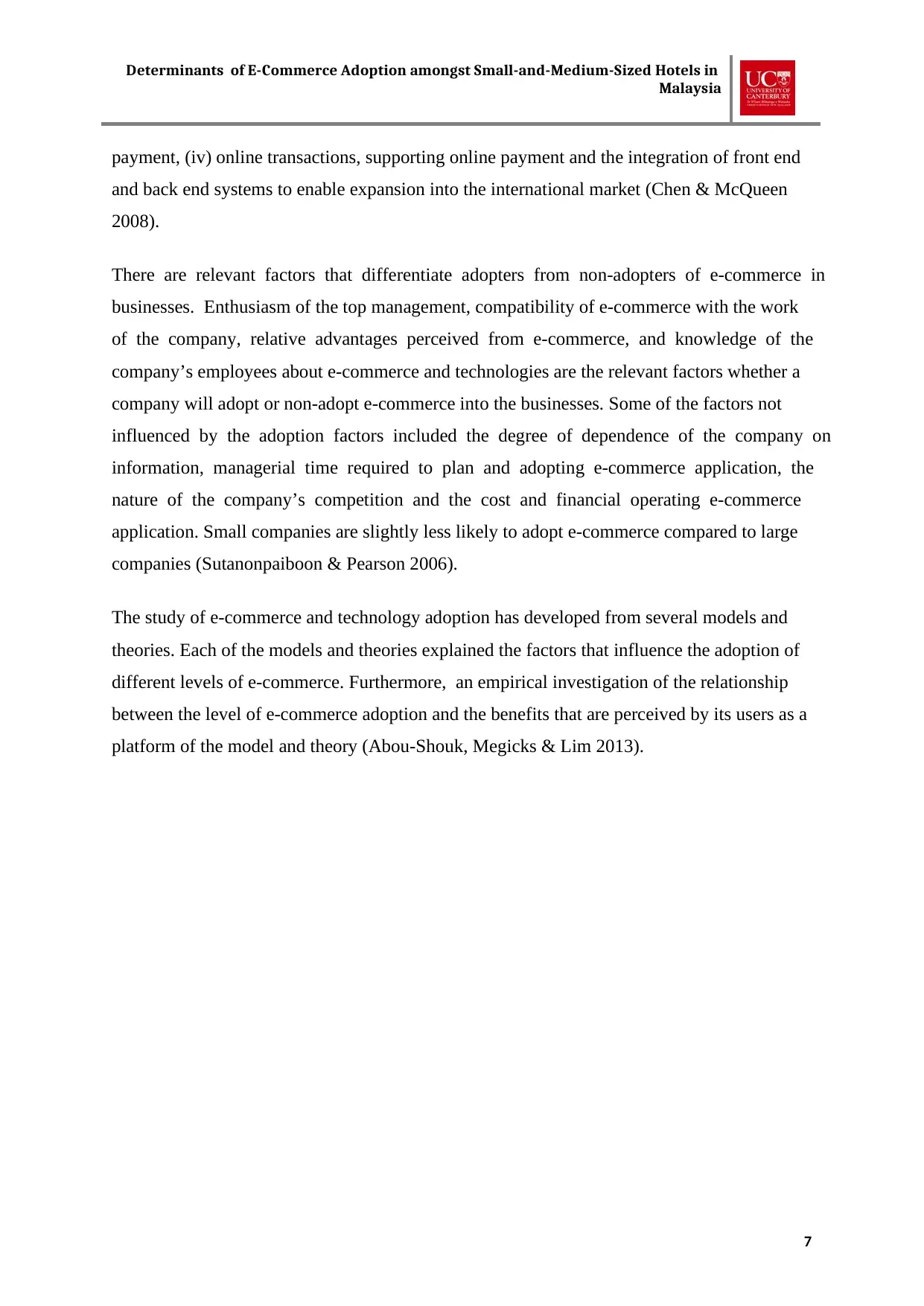
Determinants of E-Commerce Adoption amongst Small-and-Medium-Sized Hotels in
Malaysia
7
payment, (iv) online transactions, supporting online payment and the integration of front end
and back end systems to enable expansion into the international market (Chen & McQueen
2008).
There are relevant factors that differentiate adopters from non-adopters of e-commerce in
businesses. Enthusiasm of the top management, compatibility of e-commerce with the work
of the company, relative advantages perceived from e-commerce, and knowledge of the
company’s employees about e-commerce and technologies are the relevant factors whether a
company will adopt or non-adopt e-commerce into the businesses. Some of the factors not
influenced by the adoption factors included the degree of dependence of the company on
information, managerial time required to plan and adopting e-commerce application, the
nature of the company’s competition and the cost and financial operating e-commerce
application. Small companies are slightly less likely to adopt e-commerce compared to large
companies (Sutanonpaiboon & Pearson 2006).
The study of e-commerce and technology adoption has developed from several models and
theories. Each of the models and theories explained the factors that influence the adoption of
different levels of e-commerce. Furthermore, an empirical investigation of the relationship
between the level of e-commerce adoption and the benefits that are perceived by its users as a
platform of the model and theory (Abou-Shouk, Megicks & Lim 2013).
Malaysia
7
payment, (iv) online transactions, supporting online payment and the integration of front end
and back end systems to enable expansion into the international market (Chen & McQueen
2008).
There are relevant factors that differentiate adopters from non-adopters of e-commerce in
businesses. Enthusiasm of the top management, compatibility of e-commerce with the work
of the company, relative advantages perceived from e-commerce, and knowledge of the
company’s employees about e-commerce and technologies are the relevant factors whether a
company will adopt or non-adopt e-commerce into the businesses. Some of the factors not
influenced by the adoption factors included the degree of dependence of the company on
information, managerial time required to plan and adopting e-commerce application, the
nature of the company’s competition and the cost and financial operating e-commerce
application. Small companies are slightly less likely to adopt e-commerce compared to large
companies (Sutanonpaiboon & Pearson 2006).
The study of e-commerce and technology adoption has developed from several models and
theories. Each of the models and theories explained the factors that influence the adoption of
different levels of e-commerce. Furthermore, an empirical investigation of the relationship
between the level of e-commerce adoption and the benefits that are perceived by its users as a
platform of the model and theory (Abou-Shouk, Megicks & Lim 2013).
Paraphrase This Document
Need a fresh take? Get an instant paraphrase of this document with our AI Paraphraser
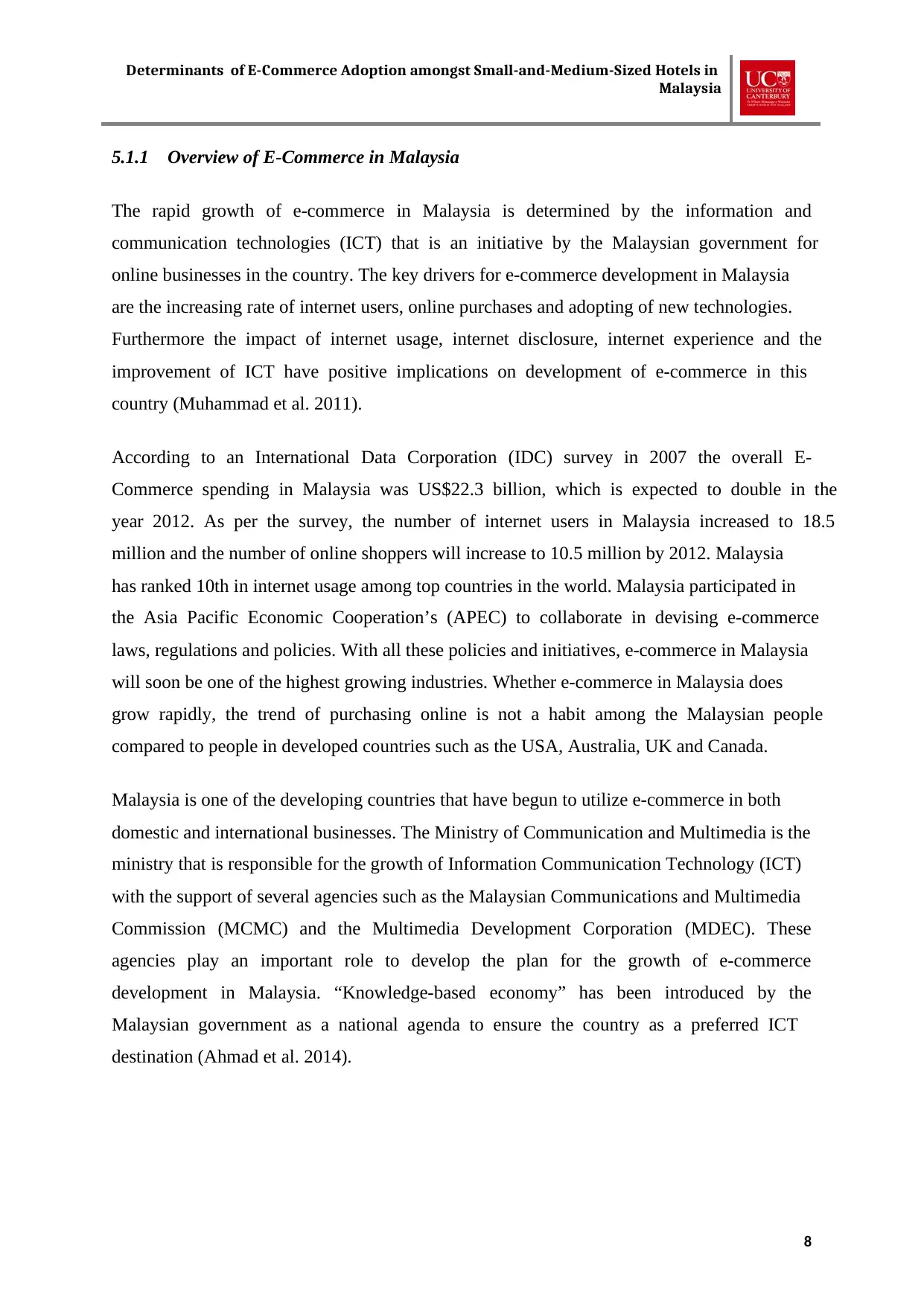
Determinants of E-Commerce Adoption amongst Small-and-Medium-Sized Hotels in
Malaysia
8
5.1.1 Overview of E-Commerce in Malaysia
The rapid growth of e-commerce in Malaysia is determined by the information and
communication technologies (ICT) that is an initiative by the Malaysian government for
online businesses in the country. The key drivers for e-commerce development in Malaysia
are the increasing rate of internet users, online purchases and adopting of new technologies.
Furthermore the impact of internet usage, internet disclosure, internet experience and the
improvement of ICT have positive implications on development of e-commerce in this
country (Muhammad et al. 2011).
According to an International Data Corporation (IDC) survey in 2007 the overall E-
Commerce spending in Malaysia was US$22.3 billion, which is expected to double in the
year 2012. As per the survey, the number of internet users in Malaysia increased to 18.5
million and the number of online shoppers will increase to 10.5 million by 2012. Malaysia
has ranked 10th in internet usage among top countries in the world. Malaysia participated in
the Asia Pacific Economic Cooperation’s (APEC) to collaborate in devising e-commerce
laws, regulations and policies. With all these policies and initiatives, e-commerce in Malaysia
will soon be one of the highest growing industries. Whether e-commerce in Malaysia does
grow rapidly, the trend of purchasing online is not a habit among the Malaysian people
compared to people in developed countries such as the USA, Australia, UK and Canada.
Malaysia is one of the developing countries that have begun to utilize e-commerce in both
domestic and international businesses. The Ministry of Communication and Multimedia is the
ministry that is responsible for the growth of Information Communication Technology (ICT)
with the support of several agencies such as the Malaysian Communications and Multimedia
Commission (MCMC) and the Multimedia Development Corporation (MDEC). These
agencies play an important role to develop the plan for the growth of e-commerce
development in Malaysia. “Knowledge-based economy” has been introduced by the
Malaysian government as a national agenda to ensure the country as a preferred ICT
destination (Ahmad et al. 2014).
Malaysia
8
5.1.1 Overview of E-Commerce in Malaysia
The rapid growth of e-commerce in Malaysia is determined by the information and
communication technologies (ICT) that is an initiative by the Malaysian government for
online businesses in the country. The key drivers for e-commerce development in Malaysia
are the increasing rate of internet users, online purchases and adopting of new technologies.
Furthermore the impact of internet usage, internet disclosure, internet experience and the
improvement of ICT have positive implications on development of e-commerce in this
country (Muhammad et al. 2011).
According to an International Data Corporation (IDC) survey in 2007 the overall E-
Commerce spending in Malaysia was US$22.3 billion, which is expected to double in the
year 2012. As per the survey, the number of internet users in Malaysia increased to 18.5
million and the number of online shoppers will increase to 10.5 million by 2012. Malaysia
has ranked 10th in internet usage among top countries in the world. Malaysia participated in
the Asia Pacific Economic Cooperation’s (APEC) to collaborate in devising e-commerce
laws, regulations and policies. With all these policies and initiatives, e-commerce in Malaysia
will soon be one of the highest growing industries. Whether e-commerce in Malaysia does
grow rapidly, the trend of purchasing online is not a habit among the Malaysian people
compared to people in developed countries such as the USA, Australia, UK and Canada.
Malaysia is one of the developing countries that have begun to utilize e-commerce in both
domestic and international businesses. The Ministry of Communication and Multimedia is the
ministry that is responsible for the growth of Information Communication Technology (ICT)
with the support of several agencies such as the Malaysian Communications and Multimedia
Commission (MCMC) and the Multimedia Development Corporation (MDEC). These
agencies play an important role to develop the plan for the growth of e-commerce
development in Malaysia. “Knowledge-based economy” has been introduced by the
Malaysian government as a national agenda to ensure the country as a preferred ICT
destination (Ahmad et al. 2014).
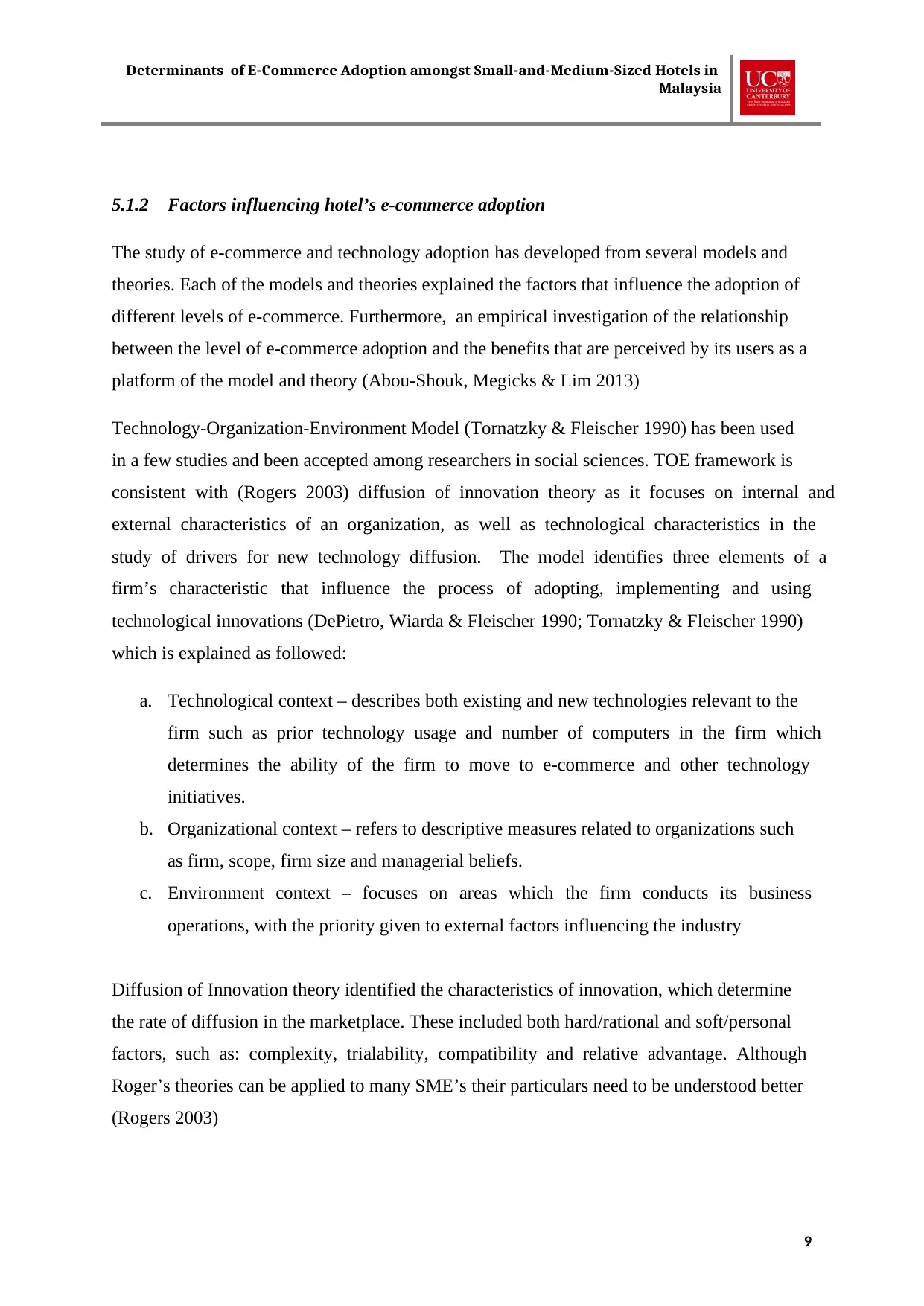
Determinants of E-Commerce Adoption amongst Small-and-Medium-Sized Hotels in
Malaysia
9
5.1.2 Factors influencing hotel’s e-commerce adoption
The study of e-commerce and technology adoption has developed from several models and
theories. Each of the models and theories explained the factors that influence the adoption of
different levels of e-commerce. Furthermore, an empirical investigation of the relationship
between the level of e-commerce adoption and the benefits that are perceived by its users as a
platform of the model and theory (Abou-Shouk, Megicks & Lim 2013)
Technology-Organization-Environment Model (Tornatzky & Fleischer 1990) has been used
in a few studies and been accepted among researchers in social sciences. TOE framework is
consistent with (Rogers 2003) diffusion of innovation theory as it focuses on internal and
external characteristics of an organization, as well as technological characteristics in the
study of drivers for new technology diffusion. The model identifies three elements of a
firm’s characteristic that influence the process of adopting, implementing and using
technological innovations (DePietro, Wiarda & Fleischer 1990; Tornatzky & Fleischer 1990)
which is explained as followed:
a. Technological context – describes both existing and new technologies relevant to the
firm such as prior technology usage and number of computers in the firm which
determines the ability of the firm to move to e-commerce and other technology
initiatives.
b. Organizational context – refers to descriptive measures related to organizations such
as firm, scope, firm size and managerial beliefs.
c. Environment context – focuses on areas which the firm conducts its business
operations, with the priority given to external factors influencing the industry
Diffusion of Innovation theory identified the characteristics of innovation, which determine
the rate of diffusion in the marketplace. These included both hard/rational and soft/personal
factors, such as: complexity, trialability, compatibility and relative advantage. Although
Roger’s theories can be applied to many SME’s their particulars need to be understood better
(Rogers 2003)
Malaysia
9
5.1.2 Factors influencing hotel’s e-commerce adoption
The study of e-commerce and technology adoption has developed from several models and
theories. Each of the models and theories explained the factors that influence the adoption of
different levels of e-commerce. Furthermore, an empirical investigation of the relationship
between the level of e-commerce adoption and the benefits that are perceived by its users as a
platform of the model and theory (Abou-Shouk, Megicks & Lim 2013)
Technology-Organization-Environment Model (Tornatzky & Fleischer 1990) has been used
in a few studies and been accepted among researchers in social sciences. TOE framework is
consistent with (Rogers 2003) diffusion of innovation theory as it focuses on internal and
external characteristics of an organization, as well as technological characteristics in the
study of drivers for new technology diffusion. The model identifies three elements of a
firm’s characteristic that influence the process of adopting, implementing and using
technological innovations (DePietro, Wiarda & Fleischer 1990; Tornatzky & Fleischer 1990)
which is explained as followed:
a. Technological context – describes both existing and new technologies relevant to the
firm such as prior technology usage and number of computers in the firm which
determines the ability of the firm to move to e-commerce and other technology
initiatives.
b. Organizational context – refers to descriptive measures related to organizations such
as firm, scope, firm size and managerial beliefs.
c. Environment context – focuses on areas which the firm conducts its business
operations, with the priority given to external factors influencing the industry
Diffusion of Innovation theory identified the characteristics of innovation, which determine
the rate of diffusion in the marketplace. These included both hard/rational and soft/personal
factors, such as: complexity, trialability, compatibility and relative advantage. Although
Roger’s theories can be applied to many SME’s their particulars need to be understood better
(Rogers 2003)
⊘ This is a preview!⊘
Do you want full access?
Subscribe today to unlock all pages.

Trusted by 1+ million students worldwide
1 out of 59
Related Documents
Your All-in-One AI-Powered Toolkit for Academic Success.
+13062052269
info@desklib.com
Available 24*7 on WhatsApp / Email
![[object Object]](/_next/static/media/star-bottom.7253800d.svg)
Unlock your academic potential
Copyright © 2020–2025 A2Z Services. All Rights Reserved. Developed and managed by ZUCOL.





